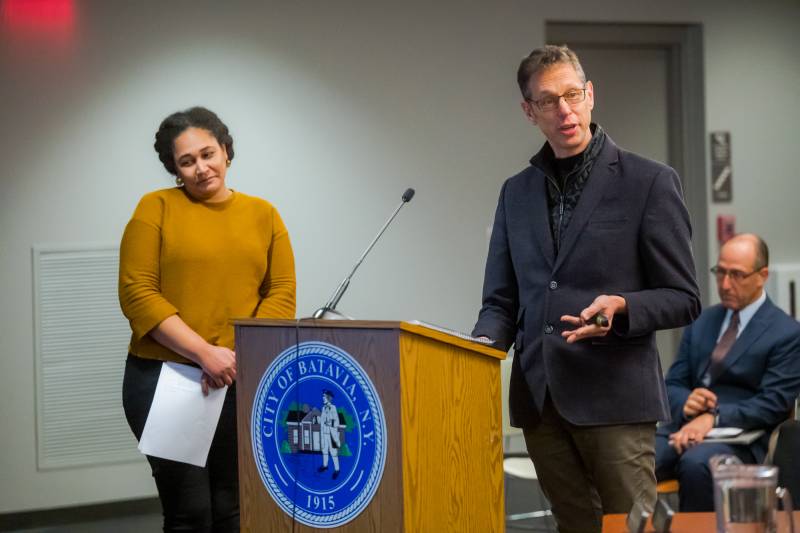
Photo by Howard Owens.
Given the ample time and 80-plus page report he had to work from, consultant Rick Hauser wasn’t short on words in a study on Brisbane Mansion. However, three words seemed to capture it best.
“It’s a gem,” he said Monday during a presentation to City Council. “I love the history of this building, it’s a 107-year-old building. So for starters, that's impressive.
“It’s at a key location in your community,” he said. “One thing’s clear is that Brisbane Mansion is not being put to its best use.”
Hauser, a partner of Inside Architecture in Perry who has conducted a reuse analysis on the Main Street structure, otherwise known as the current city police station, reviewed the site from top to bottom.
After reviewing and calculating existing floor plans, construction cost estimates, various options, forensic building timelines, potential grant and other financial incentives, a zoning map, photographs, a condition assessment, and design challenge considerations, Hauser and fellow designer Larissa Reynolds presented what they believed were the two most viable options.
One option is to carve out 11 market-rate apartments, with four two-bedroom and seven one-bedroom units on the first and second floors. All of them would be light-filled with an open kitchen, dining and living concept, comfortably-sized bedrooms and ample closet space, and they strive to maintain existing partitions, opening and architectural features as much as possible, he said.
Preserving the historic integrity of the building is key, he said, as it is currently a contributing member of the historic district and is on the National Register of Historic Places. Maintaining historic integrity will be a principal selling point, he said.
The business plan includes utilizing grant funding which means renovation plans will be scrutinized as to whether they have an adverse impact not he remaining historic fabric and defining architectural features such as existing facades, structural elements, circulation paths, interior spatial layouts and finishes.
The second option would be a 16-room boutique hotel containing seven micro units, three deluxe units and six deluxe suites to accommodate different needs and budgets while remaining unique and welcoming.
“When we're thinking about what we're proposing for this building, we're really thinking about what the building wants to be. Because a lot of things are all set, the location of the building, centrally located to everything basically in Batavia, there is no other kind of lodging or hotels in the city core,” Reynolds said. “The history of it, the quirkiness of it, those are the key ingredients that really make a really nice boutique hotel. A boutique hotel that’s really well managed by someone that's gonna love and showcase the history and the elements of it.”
The most challenging task for these options was to work within multiple “levels within levels” by various additions and renovations done to the building at varying stages and time periods.
Who’s going to want to come in and develop an old mansion-turned-police station? Any number of people, apparently. It’s a tempting opportunity, Hauser said, because of its age: the property qualifies for historic preservation tax credits, which can be very attractive to developers and help provide key capital up front, especially if syndicated, he said.
New York State is also rich in funding sources, including grants such as Restore NY and Downtown Revitalization Initiative funds, he said.
What would this all cost a prospective developer? An estimated $3.5 million to $4 million, he said, with revenue for high-end apartments reaping $164,000 a year.
Councilman John Canale asked if any developers have expressed interest in the site at this point, and City Manager Rachael Tabelski said yes, that Batavia Development Corp. Director Tammy Hathaway has taken a few prospective developers on tours of the property.
Council President Eugene Jankowski Jr., a retired city police lieutenant, knows the building well and looks forward to its next life, he said.
“I love that old historic building. The public should be aware that we're definitely trying to repurpose it,” he said. “And at no time, we haven't even begun to discuss anything other than keeping the building there and repurposing it into something that is hopefully gonna get on the tax roll.”
The process will most likely involve a request for proposals once the city is ready to move forward, Tabelski said, and the police department has its new home at Alva Place and Bank Street.
